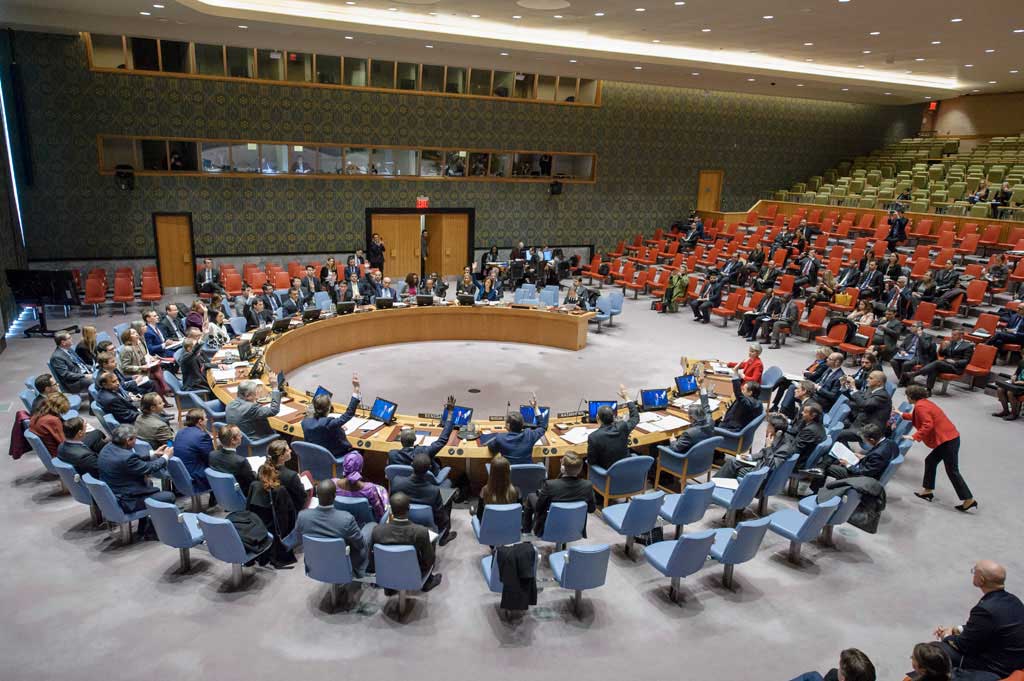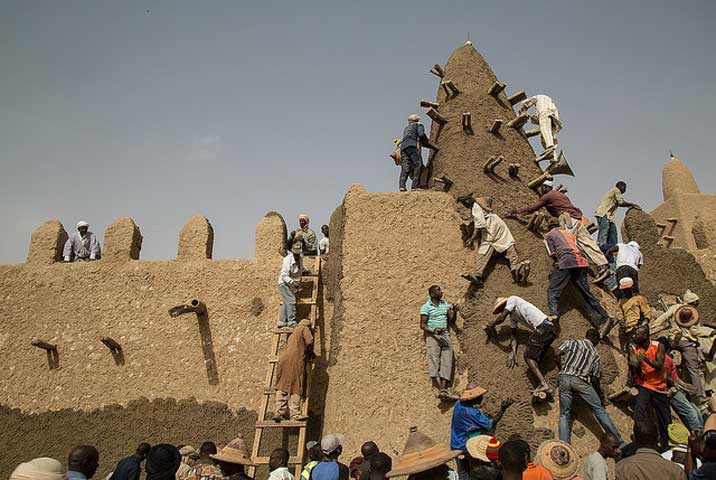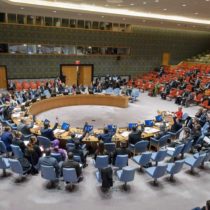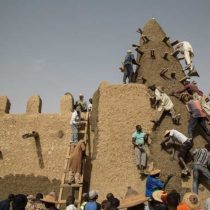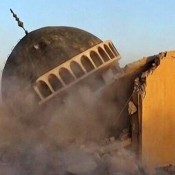In November 2015, the 38th UNESCO General Conference adopted (note 1) the Six-Year Strategy (Strategy) (note 2) on “Reinforcement of UNESCO’s action for the protection of culture and the promotion of cultural pluralism in the event of armed conflict”. Its dual objective (paragraph 16) is on one hand to strengthen Member States’ capacity to prevent, mitigate and recover the loss of cultural heritage and diversity, and on the other hand to integrate the protection of culture into humanitarian action, security strategies and peace-building processes, by engaging with relevant stakeholders outside the culture domain. The objectives (paragraph 15) serve the dual purpose of the Strategy: on the one hand, to reduce the vulnerability of the cultural heritage which lies at the forefront of the conflict and on the other hand to enhance UNESCO’s capacity to respond to crisis situations.
Reducing vulnerability will be achieved by strengthening Member States’ capacities to protect their cultural heritage and not only to assist other states when requested, but also the UN peacekeeping missions, when the United Nations Security Council (UNSC) considers it necessary. This, in turn, will integrate culture into security, humanitarian and peace-building planning at national, regional and international level. UNESCO will therefore be able to capitalize the potential of Member States by improving its operational capacity and be able to participate in decision-making on issues of international peace and security by upgrading its prestige as an international player. A key tool for achieving the above is the creation of a Rapid Reaction Mechanism. Why?
Firstly, the Rapid Reaction Mechanism (RRM) will be a kernel of national experts, which will help to create, through counseling, training and technical assistance programs, other such kernels in countries affected by armed conflicts. Secondly, it will help create more integrated, multidimensional peacekeeping missions to stabilize fragile states, enhancing the capacity of the Blue Helmets to protect weak state authorities in their efforts to rescue their cultural heritage. Thirdly, it will help to integrate culture into the structure of UN humanitarian aid, possibly by creating a cultural “cluster” (note 3).
According to Resolution 38C/48, the Director-General should work out an Action Plan in collaboration with Member States and relevant bodies and explore practical ways to implement such a RRM, concluding a proposal (Proposal). Consequently, a consultation started and was extended beyond what was foreseen (note 4), due to disagreements and reservations for the implementation and maintenance of the RRM.
In the first part of the article, we will examine the role of the RRM in achieving the two strategic objectives, taking into account the Strategy text, the proposed Action Plan and the Member States’ comments during the consultation. We choose to highlight the challenges posed to the RRM that is under modulation, on the one hand by the military targeting process and on the other hand, by the approach of non-state armed groups, in order to highlight the legal, political and organizational aspects of the consultation for the creation of the RRM. Following, we will present questions that the Proposal is trying to answer, such as how to select the experts, what are their obligations, in what context, how and when will they be mobilized? Will they be prepared to face security challenges? Finally, we will incorporate the discussion into the constraints and perspectives of UNSC Resolution 2347 (2017) (note 5), the first one focusing exclusively on cultural heritage.
RRM in the light of the first strategic objective
In terms of technical assistance, RRM experts should carry out a rapid assessment of damage, determine what urgent measures should be implemented and also technically support them, including urgent documentation, stabilizing structures, salvaging and storing collections, transporting movable cultural property into safe haven. The short-term action “First aid and mitigation measures” as well as the mid-term “Facilitate the creation of safe havens for cultural property” are relevant.
At a specialized training level, experts will use customized educational material to:
Training of military personnel, police and customs in the host country, justice and culture professionals, civil servants and art market professionals in order to familiarize themselves with International Law, prevent and tackle the illicit trafficking of cultural property. Relevant short-term action “Development of training tools and piloting of trainings for national law enforcement, armed forces and legal sectors on cultural property protection and illicit trafficking of cultural objects.”
First aid training, using rapid damage assessment tools, and building on ICCROM’s (note 6) international training program, “First Aid to cultural heritage in times of crisis” (note 7) and the experience of the Libya program (note 8), will help domestic agencies to strengthen their capabilities in evacuation, protection, safeguarding and recovery of cultural heritage during emergencies. The short-term action “First Aid training for the culture sector” is relevant.
Training in support of internally displaced and refugees, such as psychosocial and educational programs, vocational training, etc. The experts will work with local actors working in refugee and displaced camps and will train “facilitators” who will later work to develop adapted training material. The mid-term action “Learning through heritage: promoting cultural pluralism and enhancing youth engagement around culture” is relevant.
At an advisory level, among other things, they will help national authorities to digitally document their cultural heritage and develop “no-strike” lists, which will inform the military forces about cultural positions that should not be targeted. Relevant is the mid-term action “Preparatory documentation, risk assessment and emergency plans for heritage in peripheral zones”.
“No-strike” lists and targeting process
During the first consultation (note 9), the United States noted that the placement of sites in the “no-strike” list is the responsibility of the army using it, stating that the correctness of the military action is not determined by UNESCO but it is based on the legal obligations of the opponents. This was repeated during the second consultation (note 10), making clear that the “no-strike” lists are tools, the army uses to implement policy and impose legal constraints on the military operations.
This signifies issues of jurisdiction between the army and UNESCO in the field, hence between the experts and the military operational commander. On the other hand, it raises the question on the feasibility of establishing a role that will sum up in one person the technical, legal and military expertise on the protection of cultural heritage in armed conflicts and will advise the commander.
Who has the responsibility and the jurisdiction? According to International Humanitarian Law (IHL), cultural objects are considered to be intrinsic civilian objects and therefore their targeting is prohibited (note 11), and specifically some of them are subject to a special or enhanced protection, the breach of which gives rise to criminal liability.
However, a change in the acquired (note 12) characteristics of the cultural asset, e.g. if a house of prayer is converted into a weapons store, this can transform it from a cultural object into a legitimate military objective. Whether its destruction, intentional or not, meets the requirements of “military necessity”‒meaning whether it contributes effectively to military action, offers a clear military advantage and there is no other feasible alternative (note 13)‒ can only be judged by the commander of the battalion operating in the area where cultural property is located and who is solely responsible for taking such a decision (note 14).
Nevertheless, such a target in the targeting process, remains “sensitive” because any attack on it, whether intentional or collateral, is justified only if, at a given time and occasion, there is an imperative military necessity. Therefore, the armed forces of the states that have ratified the 1954 Hague Convention are subject to its legal constraints. They are also subject to the pressure put on them by international public opinion, which expects military forces not to target the monuments, neither intentionally nor collaterally, considering that with the modern technology weapons they possess, no collateral losses are justified and when these occur, they are intentional (note 15).
Therefore, in the spirit of the revised Action Plan, as presented at the February Intersessional Meeting (note 16), the role of the cultural experts is not to impose restrictive lists on the operational military commander but to help him develop, during the targeting process, appropriate operational maps.
Hallet, by exploring ways in which NATO can integrate cultural heritage protection into its operations, argues that the targeting process itself favors this integration, mainly because it is open to inputs from many disciplines that offer the means to achieve the desired results and avoid the unwanted ones (note 17). Hence, the expertise of the RRM and the relevant “no-strike” lists could expand the resources available to the army.
Similarly, the training provided by the RRM (familiarity with key regulatory texts, techniques and procedures for the recognition of cultural objects in the field, guidance for preventing damage during military operations and also preventing plunder and smuggling) could enhance the army’s capacity to achieve its objectives, to comply with the Hague Convention and to interoperate (note 18) with UNESCO.
The organizational element that would facilitate interoperability is the constitution of a cultural property protection organization in the army structure, in accordance with article 7 of the Convention. That will mediate between the commander, the relevant political authorities and the experts on the one hand, and on the other hand, will advise its operational commander to maintain the balance between legal obligations and military necessity (note 19).
Summarizing, RRM, after the request of crisis-affected states, will provide them with technical support, including “no-strike” lists, meeting the first strategic objective of “capacity building” of national authorities. Similarly, promoting these lists at the disposal of military leadership, combined with staff training, serves not only the “capacity building” of the army but also the “mitigate of vulnerability” of the cultural heritage at the frontline of conflicts. Finally, the establishment of an advisory service in the army structure not only strengthens UNESCO’s regulatory power, but also facilitates the expansion of the decision makers’ “orientation” (note 20), thus satisfying the second strategic goal of “incorporating the protection of cultural heritage in security strategies”.
RRM in the light of the second strategic objective
In regard with the incorporation of cultural heritage protection into UN peacekeeping missions, the RRM is expected to work in the field if the UNSC gives a relevant mandate, in order to contribute to the specialized training and awareness-raising of blue-helmets on the basic principles of IHL cultural heritage, as well as to the development of “no-strike” lists, based on UNESCO’s cooperation with MINUSMA (note 21) in Mali. Relevant is the short-term action of “Integration of the protection of cultural heritage […] including UN peace-keeping operations”.
In regard with the integration of culture into humanitarian action, RRM, together with humanitarian actors, could organize special events and training programs specifically for displaced persons and refugees, with a view to their local integration into the host communities or their reintegration. Relevant is the mid-term action “Integration of culture into humanitarian relief efforts related to displacement”.
In regard with the promotion of the protection of cultural heritage to the Armed Non-State Actors (ANSAs), RRM’s contribution is questionable. Relevant is the short-term action “Promoting the protection of cultural property in the event of armed conflict‒as part of International Humanitarian Law‒among Armed Non-State Actors (ANSAs)”. This action includes among other things, the development of training materials for training and awareness raising of ANSAs, directly or through NGOs such as the Geneva Call. Although this action is on the logic of creating “protected cultural zones” through agreements with state and non-state armed groups, it poses security challenges to the state actors, and so RRM’s involvement in educational actions with ANSAs seems unlikely. We will explain why further down.
State sovereignty and compliance of ANSAs
In regard with the promotion of the protection of cultural heritage in ANSAs, there have been reactions: Brazil and the GRULAC group (note 22) have proposed deleting the action on the grounds that it exceeds the mandate and the capacity of UNESCO but also because there is no agreed concept in the international law for “non-state armed groups”. Turkey stated that ANSAs are terrorist organizations in which IHL cannot be implemented. In addition, because such action would legitimize them, they proposed the deletion of every reference to ANSAs and Geneva Call, due to their relations with the PKK (note 23). Firstly, armed conflicts of “non-international character” are called the civil armed conflicts between government forces and rival armed groups, which, under responsible command, control a part of state territory in which they can apply the principles of the IHL without negating the state sovereignty (note 24). In Article 19, the Hague Convention (1954) provides that each party to an armed conflict not of an international character occurring within the territory of one of the contracting parties is committed to respect cultural property by means of special agreements.
Secondly, Geneva Call (note 25) is an NGO that helps ANSAs, at their request, to comply with IHL rules through training and counseling. Its approach is based on “Deed of Commitments”, e.g. landmine ban, child protection etc., followed by implementing measures and compliance monitoring. If breaches of the agreement are found, the ANSAs’ leadership must conduct an internal investigation and punish the perpetrators. Geneva Call helps reinforce compliance mechanisms, but if it finds that leadership itself deliberately violates the agreement, it has the right to make it public.
Thirdly, the UN Secretary-General supported in his report (note 26) in 2009, the need to enhance the compliance of ANSAs (paragraph 26) and urgently develop a comprehensive approach to this end (paragraph 39). He acknowledged Geneva Call’s approach as a good practice model (paragraph 43) and made it clear that Member States should not prevent humanitarian organizations from cooperating with ANSAs, even with those that are proscribed in national legislation (paragraph 45), in order to protect the civilians.
Therefore, ratification of the Convention by the state members and of an agreement by ANSAs would provide access to the RRM, not only in areas controlled by the state but also in those controlled by ANSAs. Will UNESCO allow experts to approach ANSAs in conflict areas?
The Action Plan of June 2016 (note 27) did not provide for this, but only for the production of training and awareness material for the use of humanitarian actors interacting with ANSAs.
At the September Intersessional Meeting (note 28), Venezuela expressed fear that the ANSAs’ approach would marginalize the state’s sovereignty and security position in the international law. Francesco Bandarin (note 29) argued that UNESCO has approached again ANSAs, e.g. Taliban in 2001 on the Bambiyan disaster, and reminded that he himself had been sent to Congo to reach out to the rebels.
Despite the assurance that there is no direct contact planned (note 30), during the written consultation that followed (note 31), Turkey, Brazil and the GRULAC group deleted the action. The Intersessional Meeting of February 2017 (note 32) highlighted UNESCO’s constitutional right to offer services to “parties” of non-international conflict, “directly or indirectly through NGOs”. At the March Information Meeting (note 33), Mechtild Rossler (note 34) added the triple argument: the action in question reflects the provisions of the 1954 Convention, which Turkey and the US have ratified, it is a well-established UN policy, and it does not affect the legal status of the parties in the conflict. In an effort to reach consensus, she suggested that the phrase “directly or indirectly through NGOs” be removed. Impressively, in the progress report, submitted on March 24 at the 201st Session, not only the phrase but also the whole action had been removed (note 35).In fact, Geneva Call already offers training programs for the protection of cultural heritage in times of war, e.g. to ANSAs in Syria (note 36) and has already carried out a study on the legal framework and the type of actions that UNESCO can take in relation to ANSAs, the risks and opportunities that characterize such an operation (note 37).
Proposal for the establishment of a RRM
The UNESCO Member States were invited to form a Proposal for the establishment and operation of the RRM. The proposal was first based on the premise that, in order to ensure the effectiveness and the efficiency of the response, the RRM should be based on a Roster of national experts set up by UNESCO, ready to be sent to the field.
UNESCO already maintains rosters of experts (note 38): of culture, education, external relations, natural sciences, etc. The culture roster includes skills in archeology, architecture, history of art, conservation, cultural management, etc. It defines (note 39) “expert” as a recognized specialist with particular skills, expertise or knowledge who is contracted by UNESCO for a short period of time, either in an advisory or consultative capacity or to provide a product or service. It encourages candidates from all geographical regions to register their interest in the relevant link (note 40) by providing a relevant application guide.
The experts of the RRM will have the status of “UNESCO experts” whether they sign an individual contract with UNESCO or can be made available by the state service where they work, by loan (note 41). The experts will maintain employment relationship with their state services, but will be subjected, from one to three years, under the operational and technical supervision of UNESCO. This means that experts cannot seek or receive instructions from other entities nor participate in actions incompatible with the terms of their contract; otherwise, their employer would have to compensate UNESCO accordingly. According to the proposal, they will be asked to confirm every two years their readiness to mobilize within a short period of time, possibly in areas affected by conflict or natural disasters.UNESCO already draws experts from two “stand-by” partners, i.e. organizations that maintain large rosters of certified staff: the Norwegian Refugee Council (NRC) and CANADEM (Canada’s Civil Reserve) NGOs, with which it has concluded stand-by agreements in 2007 and 2010 respectively. At the request of UNESCO and after the stand-by partner approves it, experts are mobilized at UNESCO regional offices to assist in post-conflict situations or natural disasters (note 42).
Questions
Regarding the selection of the candidates, the original Proposal (note 43) provided that the roster would be open to all, including experts from NGOs or seconded persons from governments, through a call for interest addressed by UNESCO. This wording was soon abandoned and the issue was limited to the fact that the candidates would be “national” and their mobilization would be subject to an agreement between UNESCO and the home country.The above are of interest in relation to a Canadian indication that a clear distinction should be made between the involvement of police, military and civilian experts, particularly in relation to missions in conflict situations (note 44). In all versions of the Proposal, there is an indirect answer that the experts will perform tasks related exclusively to their technical or legal expertise, no matter if they were citizens, military or police in their country. This is important, as there are countries that have already included the protection of cultural heritage in military training (note 45), so they are expected to feed the RRM with military personnel.Austria, for example, incorporates the protection of cultural heritage into military directives and has established a “Liaison Officer: Military Cultural Property Protection”, while through the Austrian Society for the Protection of Cultural Property, an NGO of which most members of the board are military officers, secures a pool of military expertise to protect the cultural heritage (note 46). The Netherlands too (note 47), maintains a reserve unit that, in their civilian life are culture professionals, available when they are called upon to accompany the Dutch army to international operations.The March progress report (note 48) clarified that the selection criteria would be set up with the assistance of a consultative committee of UNESCO’s institutional partners, such as ICOM (note 49), ICCROM, ICOMOS (note 50) and ICBS (note 51). Desired competences will not be limited to knowledge and skills within a specific cognitive area of cultural protection but will include the ability to work within a multicultural environment in crisis situations with security challenges. Special attention will be put to ensure diversity of characteristics, nationality, regional experience, language skills, and gender.What is the role of the Member States in the staffing of the RRM? Some states have expressed the desire to play a role in the selection process. France has pointed out that states should be consulted on the design of the profile. Madagascar that the roster should be staffed on the basis of proposals from the Member States (note 52). Estonia that states should know whether or not they can appoint their experts in the roster. China has suggested that it will nominate its experts to participate in the Advisory Committee or the roster, Greece has stated that in compliance with UNSCR 2199 (2015) it has already established a roster (note 53). The above action also foresees that the RRM will build on the “Memorandum of Understanding” (note 54) signed by UNESCO and the Italian Government on 16 February 2016. This Memorandum created the “Italian Task Force” (note 55) as a RRM by experts and specialist officers belonging to the Carabinieri Corps for the protection of the Cultural Heritage (Comando Carabinieri Tutela Patrimonio Culturale), with functions (note 56) according to the provisions of the Proposal. The Italian Government will appoint a Focal Point as a link to the “Italian Task Force” with UNESCO (note 57). However, the detailed operational and administrative procedures will be set out in a forthcoming separate agreement.At the request of Italy, it was included in the March proposal (note 58) that it would be possible to mobilize not only individuals but also groups, through partnership agreements with governments. We therefore assume that Italy will have control over the selection, training and preservation of the “Italian Task Force”, which could be mobilized as a team at UNESCO’s mandate, and perhaps this will ultimately be the model for establishing and operating National RRMs.When and for how long will the experts be mobilized? The Proposal provides for participation in all crisis phases related to armed conflicts and / or natural disasters. Spain pointed out (note 59) that “it is hard to imagine how culture could be protected amid the chaos of a conflict”. The US did not consider it appropriate to mobilize the RRM indiscriminately, both in non-hazardous situations of natural disasters and in extremely dangerous pre-combat and combat situations. As different security environments, they require different types of training (note 60). The reference to natural disasters remained in the March progress report (note 61); on the grounds that UNESCO has received many requests for assistance, has developed relevant experience and that mobilization in natural disasters is part of its integrated approach.In whose requests will the RRM be mobilized? Firstly, UNESCO will be able to mobilize the RRM at the request of the national authorities and in consultation with them. Although this is the usual practice of UNESCO, it has been highlighted by many states throughout the consultation.Secondly, at UNSC mandate, as part of a peacekeeping mission which would include in its mandate the protection of cultural heritage and would request UNESCO to assist, as was the case for MINUSMA in Mali.Thirdly, the possibility of mobilizing the RRM in the framework of EU, OSCE or NATO missions has been minimized. Already at the first Intersessional Meeting (note 62) in February 2016, Bandarin had pointed out that the development of a partnership with NATO was one of the UNESCO’s objectives, then a reference (Action 27) was included in the initial June Action Plan (note 63). In July, Finland (note 64) proposed to investigate the possibility of cooperating with NATO, the EU and the OSCE. In the August progress report (note 65) it was reported that UNESCO had exploratory contacts with NATO for possible cooperation, and the revised draft submitted for consultation in October (note 66) suggested that the experts could be deployed in the framework of NATO, EU, and OSCE missions. However, during the second consultation (note 67) that followed, Brazil and the GRULAC group argued that participation in military operations of international organizations or coalitions operating outside the UN system and lacking clear competence, mandate and supervision by the UNSC, should be avoided. With France in the same vein, any relevant reference disappeared from the March progress report (note 68).Will the experts be prepared enough to cope with security challenges? The Proposal foresees that they will undergo induction and specific training courses on institutional issues, the security framework of the concerned country, and on processes to which they will contribute, such as PDNA for Culture (note 69), as well as the UN online courses on security and special field briefing. Their mobilization requires compliance with the UN established standard procedures.Finland has expressed its reservation on the adequacy of online education programs, instead they proposed the HEAT training programs (note 70) certified by ENTRi (note 71) and with the realistic argument that good education costs, they proposed to take over the states themselves the responsibility to train their experts prior to mission (note 72). Therefore, at least those countries whose crisis management training centers are ENTRi implementation partners, like Finland, Austria, Italy, the Netherlands etc. have advanced skills and experience, associated with their active participation in international EU crisis management missions, the OSCE or UN peacekeeping missions (note 73) .Who will organize the mission? UNESCO will take the decision to mobilize the experts, but it is unclear whether they will organize the missions as well. If they do, they will either have to enter into a consultant contract directly with individual experts, undertaking all the costs, or a loan agreement with a government to supply staff. However, Member States have serious reservations about UNESCO’s ability to properly and adequately protect and prepare experts to be deployed to war zones.The “Italian Task Force” case as a complete group of cultural heritage professionals and specialized militarized police seems to be an ideal model. Carabinieri are operational under the Italian Ministry of Culture and have, among other things, experience in international missions, as well as advanced means of preventing the illicit trafficking of cultural property and valid training programs for crisis management (note 74). If it is the Italian government that will organize the mission, it will probably be done through a stand-by agreement, that is, they will mobilize the Task Force as a team on UNESCO’s mandate and will have the organizational and financial responsibility of the mission.Canada suggested (note 75) that an experienced “stand-by” partner could not only undertake the process of selecting and mobilizing the experts, but also organizing the mission. CANADEM has been a Lloyd Axworthy’s Flagship Canadian Initiative in 1996, as part of a policy to promote Canada’s first line of defense of “human security” through strengthening UN peacekeeping missions (note 76), a policy that seems to be a come back with the Trudeau government (note 77). Therefore, it could be argued that such a suggestion highlights the value of the RRM in the promotion of foreign policy objectives.
Epilogue
Creating and maintaining a RRM for the protection of cultural heritage in armed conflicts is an issue that raises fertile questions. Especially, the need to cooperate with the military forces, either through training or through coexistence with a multidimensional mission. The embodiment of archaeologists into the military forces invading Iraq in 2003 caused criticism, mainly on the argument that cultural professionals should not act in an abstract and non-political framework for rescuing culture but as informed citizens to consider the legitimacy of the project in which they participate (note 78). The “ghost” of the UNSC unauthorized intervention in Iraq in 2003, seems to explain the persistence of states on the fulfillment of three conditions: that the mobilization of experts is legalized only at the request of a Member State, in full consultation with it and only at the UNSC mandate.
In this sense, the “momentum” is more favorable than ever. Not only has UNSC resolution 2199 (2015) recognized the illicit trafficking of cultural property as one of the threats of international security posed by terrorist organizations in Syria and Iraq, but it has also, for the first time, given a resolution in 2347 (2017), entirely in the protection of cultural heritage in times of conflict, without being limited to the Middle East or only to terrorist organizations. Therefore, the RRM is perceived not only in terms of compliance with the UNESCO Conventions, but also with the UNSC resolutions, which are enforceable by all Member States.
The UNSC Security Council Resolution 2347 (2017) foresees that states have the primary responsibility for the protection of their heritage (paragraph 5), invites the international community to offer assistance to those states that request it (paragraph 6) and confirms (article 19) that UN peacekeeping missions may include the protection of cultural heritage in their mandate, in cooperation with UNESCO.
What do we conclude? Since it was accepted that a major factor in the financing of terrorism is the “market” countries, the UNSC was geared to strengthening international cooperation and national capabilities to combat the illicit trafficking of cultural property, which finances terrorism. In fact, it has impressively strengthened states’ compliance with the UNESCO Conventions, which in itself does not have sufficient means to do so.
Secondly, resolution 2347 devotes only a small paragraph to the inclusion of the protection of cultural property in the mandate of UN peacekeeping missions. In the same vein, MINUSMA’s example, although referring to the Strategy and the Action Plan as a successful precedent, reaches an almost crude paragraph in the March progress report (note 79). We believe that the participation of the RRM in such a mission requires a separate analysis that takes into account the challenges it poses to the balance of power of the states that influence decisions in the UNSC as well as, the nature, organization and purposes of modern multidimensional UN peacekeeping missions.
To sum up, the action of the RRM so far does not seem to depart from UNESCO’s hitherto common practice. It remains to be seen in what form and under what organizational management it will be mobilizing in countries affected by conflicts or natural disasters. UNESCO will now draw on state rosters, which will highlight specific national and regional interests and its limits as an intergovernmental organization. Finally, the withdrawal from participation in NATO, EU, OASA missions needs special attention as each of these organizations re-examines the role of culture in foreign policy (note 80) and its international missions (note 81) .
Vasiliki Georgopoulou
Graduate of the PSP in “Political, Economic and International Relations in the Mediterranean”, University of the Aegean, Service of Modern Monuments and Technical Works of Dodecanese
Eleni Papavasiliou
Archaeologist, Ephorate of Antiquities of Dodecanese
Figure sources
Fig. 1. Elias, Manuel, The Security Council unanimously adopts resolution 2347 (2017), condemning the unlawful destruction of cultural heritage in the context of armed conflicts, notably by terrorist groups. 2017. UN Photo. Accessed April 9, 2017. http://www.un.org/apps/news/story.asp?NewsID=56428#.WPUMOWclEuU.
Fig. 2. http://unpeacekeepers.tumblr.com/post/158711511184/un-peacekeeping-mission-in-mali-minusma-works. Accessed April 9, 2017.
